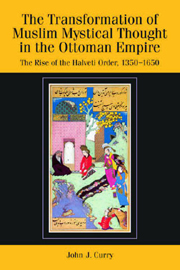 The Transformation of Muslim Mystical Thought in the Ottoman Empire
The Transformation of Muslim Mystical Thought in the Ottoman Empire from PART III - DEFENDING THE CULT OF SAINTS IN ELEVENTH/SEVENTEENTH-CENTURY KASTAMONU: TRANSFORMING THE ŞAcBÂNİYE ORDER UNDER cÖMER EL-FUɔÂDÎ
Published online by Cambridge University Press: 12 September 2012
The success of the Menâkιb among its audience in the Kastamonu region helped to consolidate the order at a time when a new generation of followers, increasingly distanced from its subject, were coming to the fore. In many cases, the work's appearance would represent the final point at which the historian could continue tracking the evolution of an order's narratives and doctrines under their hagiographer's direction. Yet what makes the Şacbâniye especially fruitful for historical inquiry is that we can continue tracking their evolution through the subsequent activities of its membership and the continued output of their leader, cÖmer el-Fuɔâdî. Growing acclaim for the Menâkýb soon translated into attempts to transform the burial place of Şacbân-ı Veli into a fully-fledged Sufi institution. This infrastructure building further swelled the order's following, which required more educational initiatives to better prepare them for growing challenges emerging during a religiously and politically turbulent eleventh/seventeenth century.
CONSTRUCTING A TOMB FOR ŞAcBÂN-İ VELİ AMID GROWING POLITICAL INSTABILITY
The spread of Fu'âdî's hagiography had an immediate impact that resonated far beyond the Şacbâniye. We have already seen its dedication to Sultan Ahmed I, and its arrival at court may well have sparked the enthusiasm of a Kastamonu native who had risen to a position of power there. This dignitary, cÖmer Kethüdâ (d. 1020/1611), had risen to become a steward to a powerful Ottoman grand vizier, Kuyucu Murad Paşa (d. 1020/1611).
To save this book to your Kindle, first ensure [email protected] is added to your Approved Personal Document E-mail List under your Personal Document Settings on the Manage Your Content and Devices page of your Amazon account. Then enter the ‘name’ part of your Kindle email address below. Find out more about saving to your Kindle.
Note you can select to save to either the @free.kindle.com or @kindle.com variations. ‘@free.kindle.com’ emails are free but can only be saved to your device when it is connected to wi-fi. ‘@kindle.com’ emails can be delivered even when you are not connected to wi-fi, but note that service fees apply.
Find out more about the Kindle Personal Document Service.
To save content items to your account, please confirm that you agree to abide by our usage policies. If this is the first time you use this feature, you will be asked to authorise Cambridge Core to connect with your account. Find out more about saving content to Dropbox.
To save content items to your account, please confirm that you agree to abide by our usage policies. If this is the first time you use this feature, you will be asked to authorise Cambridge Core to connect with your account. Find out more about saving content to Google Drive.